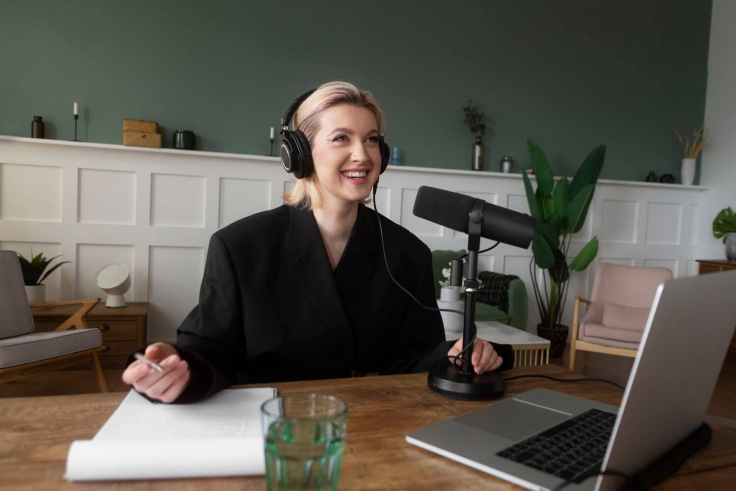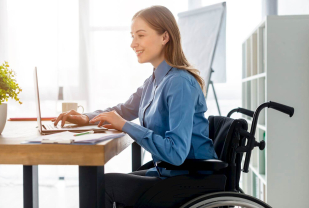To create your own podcast in college, you need to find a topic, write a script, get the right equipment, record yourself, and post your show online. This way, you can easily create a podcast to discuss important problems and share your views. According to statistics, around 47% of Americans listen to podcasts at least monthly, so your college project might eventually find a larger audience.
If you’re a student or simply want to make your own audio show, this article will be valuable for you. Here, our team will cover how to make a podcast for school from start to finish, including:
- Necessary preparation steps
- The recording process
- Free podcast makers for students
- Effective ways to promote your show
We’ve also included a bonus list of popular podcasts to help you get inspired.
🎧 What a Podcast Is (And Why You Should Create One)
A podcast is a digital audio file you can download to your computer or mobile device. It is often available as a series.
The main advantage of podcasts is that they come in all shapes and sizes. Podcast fans can find something worth listening to on any topic, of any length, and with any episode publication schedule.
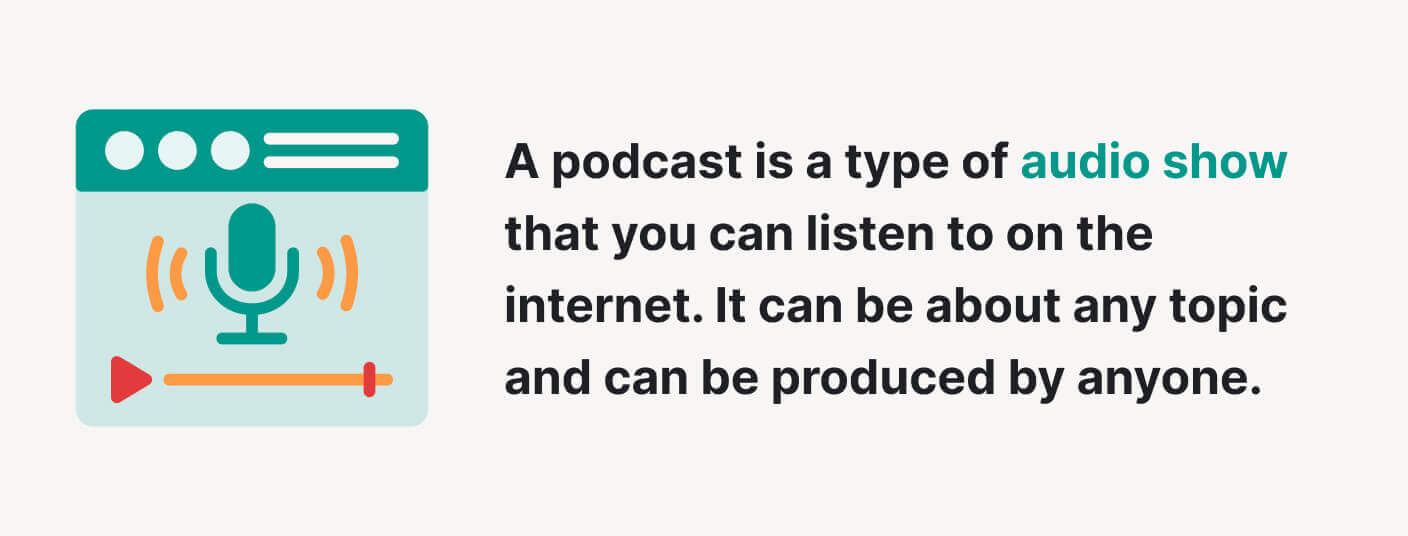
The primary aim of a podcast is to entertain and educate. However, it can also be a fantastic way to express your thoughts and opinions and share your views with an audience. It’s a fun way to develop critical skills, learn how to discuss a controversial topic, or reflect on diverse themes.
As a student, creating a podcast may become a significant step toward your development as a person and further academic success. And you’ll also have a ton of fun in the process!
🔮 Creating a Podcast: Before You Start
So, you’ve decided to start a podcast. What should be your initial step? After all, you can’t just plunge straight into the recording! You still have countless things to prepare and think about.
No worries – we took care of that. Below you’ll find a comprehensive guide on how to develop a podcast for students, starting with the preparatory stage.
Forming a Podcast Team
Before starting to work on your podcast, you must consider the number of people included.
Of course, it isn’t obligatory to involve anyone else at all. You can record your podcast all by yourself. However, it is always better to have a team, with everyone having a role that uses their individual strengths.
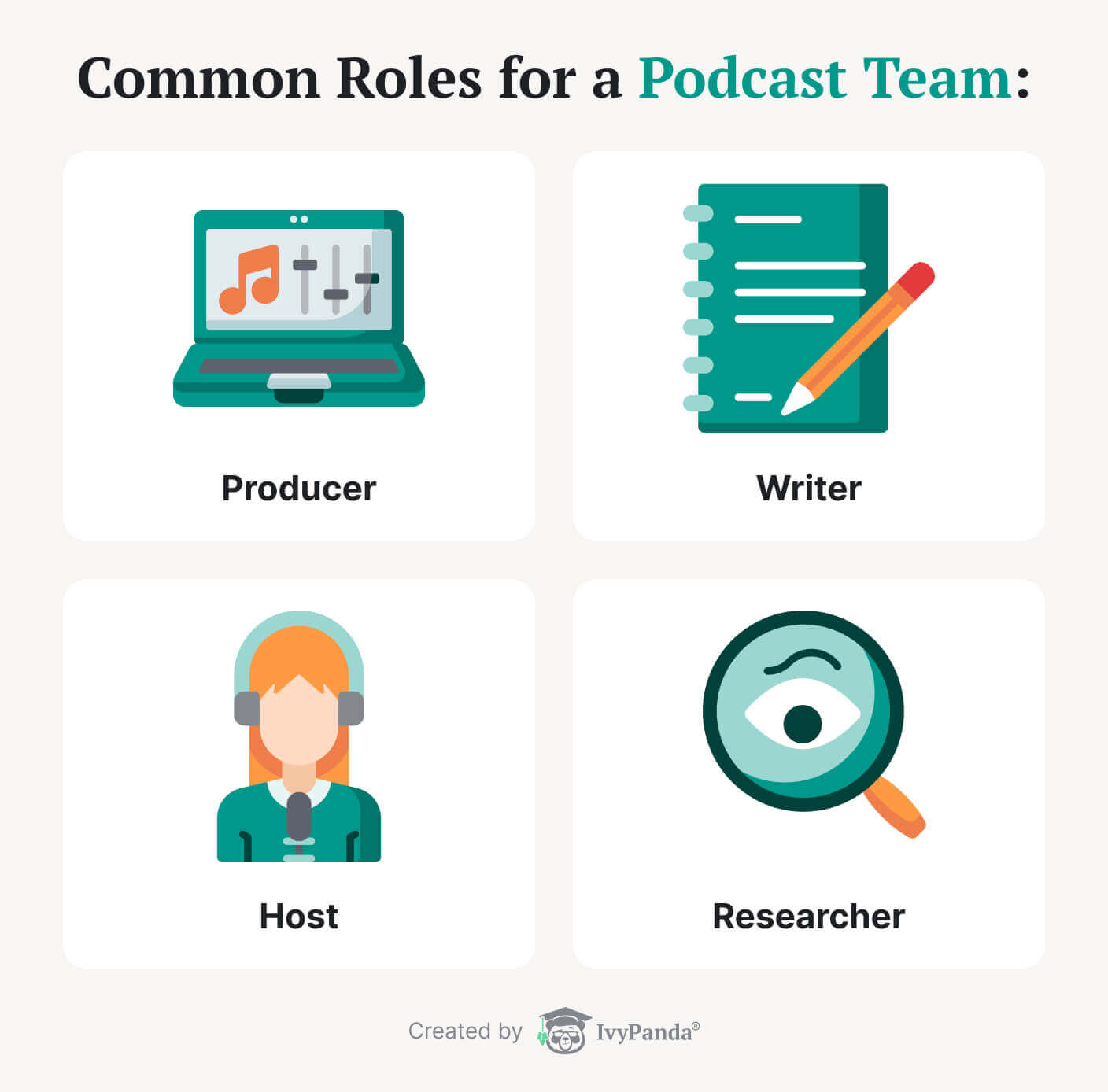
Here are primary roles in a podcast team:
- Producers manage the recording process and edit the audio.
- Writers develop scripts and questions for interviews.
- Hosts voice the program and conduct the interviews.
- Researchers investigate and gather facts.
💡 Bonus Tip:
The number of members appointed and the roles themselves are optional. It all depends on the team’s size and the podcast format.
Choosing the Type of Podcast
The format will determine the distribution of roles in your team. It may also impact the choice of topics. That’s why it should be among the primary things you decide on.
There are many podcast formats, each with specific features. Here are the types you may want to consider:
- Solo-cast monologue. This format includes just one person who dwells on a topic. It’s a popular choice for new podcasters because it’s so simple to execute.
- Informational reporting. This may include one or many participants who present the latest news and discuss real-life events.
- Interview. A podcast of this type requires a minimum of two people: a host and a guest. The host asks questions to maintain an exciting discussion.
- Conversation. This format includes two or more hosts who speak about a pre-selected topic. Usually, each host has a specific role in the conversation.
- Audio drama. This is the best format for performing a fictional story. The number of participants will depend on the narrative you wish to present.
Look through all the formats and consider their pros and cons. Which will work best for you?
💡 Bonus Tip:
Mixing several formats is also a great idea: it can make your podcast livelier and more dynamic.
Choosing the Topic
Choosing a topic for your student podcast is often a challenging task. Chances are you will start by staring at your monitor or sheet of paper and not have the slightest idea what you’re going to talk about.
Worry not! We have an efficient step-by-step guide to help you with brainstorming:
- Make a list of your favorite podcasts. Think about what makes you like them. Do they discuss a topic you’re excited about? Do they invite interesting guests?
- Sort out the podcasts you’ve listed into several categories. You may categorize them according to the theme, style, format, or other features.
- Analyze what the podcasts in your list are about. Do you notice any trends or patterns? Is there any topic you’re particularly keen on?
- Examine the type and format of podcasts in your list. What is more engaging: extended interviews about entertainment or celebrities, investigations covering social issues, or conversations on simple everyday life matters?
- Think about their length. Do you prefer listening to a long several-hour podcast or a series of short ones? What will be more suitable for your show?
- Choose the topic for your podcast based on the answers you’ve given. Maybe, examining your favorite shows has already inspired some ideas. You may take a topic from an already existing podcast you are passionate about and narrow it down, paying attention to some neglected aspect of it. Be sure to add a personal twist to make your take unique!
Need some more inspiration? Consider the following list of popular podcast topics:
- We Will Help You Do It.
A how-to podcast based on sharing valuable tips on anything you feel strongly about. - Reader’s Theater.
Create and perform your own scripts. - Ask Me Anything.
The listeners submit their questions, and you answer them on air. - Hottest Trends.
Pick something unexpected that suddenly came into fashion at your school or within your community and discuss it. - Comedy Time.
Know any amusing stories or jokes? Share them with your listeners! - Myths and (Urban) Legends.
Research traditional myths and compare them with modern-day legends. - Investigative Journalism.
Hunt down a local mystery or unsolved crime and try to investigate it. - Book vs. Movie.
Compare films and the original books upon which they were based. - Our Community.
Share the news within your community or school, post interviews with locals, or discuss urgent issues. - Let’s Debate!
At least two hosts pick any topic and debate it. You can discuss anything from a favorite song to social justice issues.
Research & Outlining
Have you decided on your topic? Great! Now, you want to make sure you can discuss it like a pro. That means doing some thorough research.
Whether you want to share some how-to tips or conduct an interview, you must still have a firm grasp of the topic’s background. Researching the subject is essential if your podcast is connected to a real-world issue. To ensure your perspective is well-informed, read only reputable sources, newspapers, and scientific articles.
Once you’re done researching and have a good grasp on the topic, start preparing a plan. Having it will help you avoid mistakes or confusion during the recording. To make a plan, follow these steps:
- Write down the core focus of the podcast episode.
- Make a rough outline, indicating the main parts and briefly stating what they will be about.
- Specify whom you’re going to interview and how you’re going to do it.
- Decide on opening and closing ideas.
- Indicate what stories you want to incorporate.

Writing the Script
Writing a script is essential for ensuring that everything will go smoothly when you start recording your podcast. To make a good script, you need to take your outline and add detail, indicating when the host will speak, when and what sound effects will be used, and when to include pre-recorded interviews.
It’s simpler than it may sound. Basically, your script will consist of 3 main parts:
- Beginning. If you want to record a successful podcast, find a way to engage your listeners from the very beginning. To get some ideas, listen to your favorite podcasts and pay attention to the hooks they use and how they introduce the episode’s topic.
- Main part. Here, you will develop the topic and ideas stated in your introduction. The tricky part is to maintain the attention of your audience. Again, try to remember the podcasts you’ve heard. What tricks do they use to keep you listening? Think about whether you can use something similar for your project.
- Ending. Consider how you’re going to finish your podcast. A weak ending can ruin the impression! So, make sure your listeners will leave with a feeling of closure and satisfaction.
Check out some more advice on scripting different types of podcasts below:
- Interview.
Contact the people want to interview beforehand, invite them to appear on your show, and tell them what exactly you’re going to discuss. This way, they’ll be able to prepare for the podcast. If they decline your invitation, thank them politely. - Stories or narration.
Aside from writing what you’re going to say, you should also script the necessary sound elements. If your narration includes parts of the interview, script them as well. - Conversations.
Such podcasts often seem like improvisations, and, of course, you can improvise, but you’ll still need at least a rough script to keep you on track, just in case.
🎙️ Technical Preparation for Creating a Podcast
Now you’re ready to start recording your first podcast. Are you feeling nervous? There’s nothing to worry about: with our help, you’ll be able to ace it. We will tell you exactly what to do and how to do it.
Ready? Let’s get started!
Equipment
Here’s the good news: successful podcasting doesn’t require a lot of fancy equipment! Chances are, you already have everything necessary: your smartphone, iPad, laptop, or desktop computer. To create a student podcast, you just need anything that allows you to record an audio file, edit it, and publish it online.
💡 Bonus Tip:
To improve the sound quality, buy an external microphone. Most microphones include USB cables; you can use them with any device with the corresponding port.
Not sure what to choose? Here are the top 5 devices we recommend:
- Shure MV7. This is a high-quality mic that can function with both XLR and USB connections. It’s easy to use, even for beginners. However, it is costly.
- Blue Microphones Yeti USB. One of the best microphones for podcasting, streaming, and vlogging. It’s inexpensive and simple, but the standard version has USB output only.
- Rode Procaster. This dynamic mic with an XLR connection is explicitly created for speech recording and perfectly copes with ambient noise.
- Audio-Technica AT2035PK. It’s a versatile, easy-to-use microphone that fits both vocal and instrument recording.
- Rode NT-USB. This classy-looking, USB-only mic is a perfect set-and-forget desktop option. It’s versatile enough and requires no preamp or audio interface.
Podcast Audio
Sound effects are a great way to make your podcast enjoyable and unique. Good sound selection may become the very thing that makes your podcast recognizable.
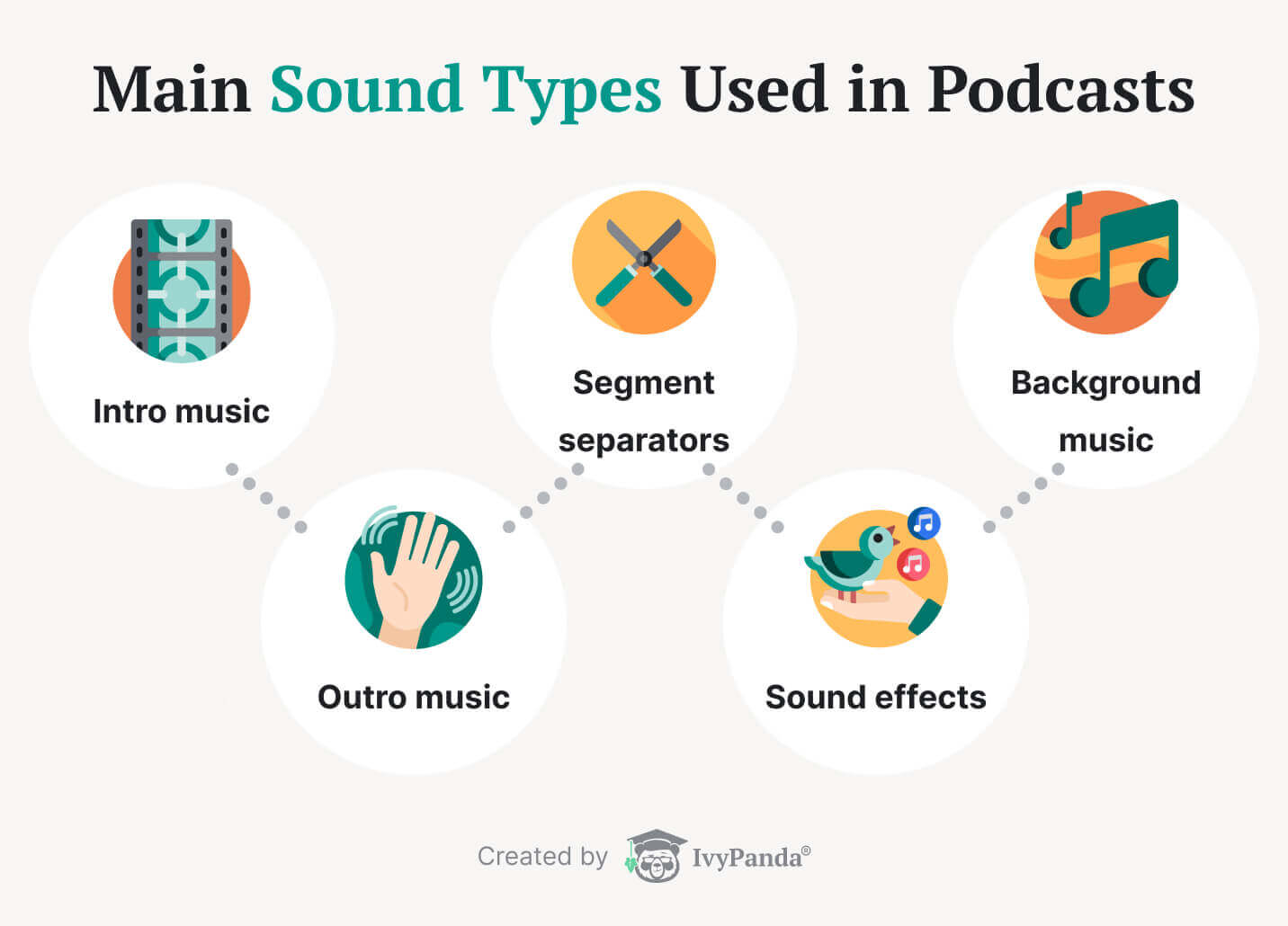
Here are the sound types you need:
- Intro music. People will associate this opening jingle with your show, so make sure it’s catchy and represents your podcast well.
- Outro music. The easiest option is to choose something relaxing, but it’s not a compulsory rule. You can have fun and use your imagination when selecting outro music.
- Segment separators. Using short instrumental snippets helps to draw attention to a new segment.
- Sound effects. Natural background noise can help your listeners create a more vivid mental image. But there are two things to consider: it must help describe the environment, and it mustn’t be too loud or distracting.
- Background music. Some podcasters play music throughout the episodes to make them more atmospheric. It’s essential to keep the volume of the music lower than the volume of the spoken word to ensure the podcast is easy to understand. Also, consider the tone of your podcast: for a serious topic, use solemn and slow melodies, and for a light-hearted one, use upbeat and happy music.
💡 Bonus Tip:
Mix the music and audio levels professionally to ensure everything sounds balanced and polished.
Now, you’re probably asking: “Where do I get this audio from?”
Well, you have two options: recording your own music and sound effects or downloading it from public domain websites. Here’s a list of our favorite free podcast music resources:
- Pixabay
It’s a free platform with many audio tracks, pictures, and videos. Pixabay’s license allows you to use music for your project without paying any fee or giving credit to the author. - YouTube Audio Library
You can find this library within YouTube Studio. It contains a wide selection of free-to-use music and sounds. - 909 Music on Soundcloud
It’s a small library of the newest music that can work well as your podcast’s intro or outro songs. - Incompetech.com
The site contains hundreds of songs and is very popular among podcasters. However, you must credit the author if you’re using the tracks for free. - Freemusicarchive.org
It’s an extensive library of free high-quality music. To access it on an Android or iOS device, download the FMA app.
💡 Bonus Tip:
Read the terms of use for each file cautiously because the licenses may differ. Some songs may be free to use for student podcasts but not for commercial purposes.
Tools & Apps
The choice of tools and apps for creating a podcast will depend on your device. Perhaps you’re going to record and edit on your school-issued Chromebook or iPad. Or maybe you are allowed to use your smartphone. In any case, make sure the device you use can save and share files in MP3 format. If not, you’ll have to install one.
To facilitate your podcasting experience, go through this list of top apps that will help you record, edit, and share your files:
- Anchor app for iOS or Android
This popular free app allows you to record your podcast, edit, and publish it on popular podcast services right from your smartphone or tablet. - Audio Joiner
Use this online app to merge multiple tracks into one. It supports about 300 audio formats and converts them to MP3. - Voice Recorder
It’s a free and simple online tool. You can use it to record your voice, crop your recording, and save it as an MP3 file. - Audacity
Install this free software on your computer if you need extended editing possibilities. - GarageBand
This software allows you to create music or podcasts like a pro on your macOS, iPadOS, or iOS device.
Want to know the best part? All these apps are free!
Revision & Publishing
Congratulations! Your audio is ready. There are just 2 last steps: to revise it and then share it with your audience.
Listen to your edited podcast from the very beginning and answer the questions:
- Is it engaging?
- Would you personally enjoy and share it?
- Do you want to change anything?
If everything is alright, you can publish the podcast!
Here’s what you can use to share the episode you’ve created:
- Google Slides
It’s not a typical podcast publication method, but it’s great for student projects. You can upload your MP3 file to Google Drive and copy and add the link to the corresponding slide. The benefit of this method is its simplicity and control over who has access to the podcast. - Anchor
With Anchor, you can record and edit your podcast as well as post it to services like Apple podcasts or Google podcasts. This is very useful if your project is intended for an audience outside the classroom. - YouTube
It’s a free and straightforward method that demands minimal prior knowledge. The only problem is that you’ll have to convert your MP3 file to video format before posting it to the platform. For this purpose, use screen recorders or programs like Loom, Screencastify, WeVideo, or something similar. - Libsyn
It’s another service that makes the posting and sharing process super simple and intuitive. However, it requires a monthly fee for storing your podcasts.
🎁 BONUS: List of the Best Podcasts for Inspiration
We hope this article inspired you to create a podcast! Before you go, check out this list of our favorite student podcasts. They will spark your inspiration and teach you a trick or two:
- The 5 AM Miracle. Does your college life seem overwhelming? This podcast’s host, Jeff Sanders, shares advice on coping with the demanding student life and staying productive.
- How the Worst Procrastinator I Know Led Seattle’s March for Our Lives. In this short podcast, students Aliyah Musaliar and Maya Konz discuss a gun-violence protest in their city. Mainly, they focus on the leader of the protest.
- The College Investor. It’s a daily podcast that educates students on diverse financial topics. Robert Farrington explains how to repay student loans and start to build your wealth.
- TED Talks Daily. This is one of the most diversified podcasts. It discusses everything, from AI to everyday problems, in the form of well-structured speeches.
- Sexism at Lillian Osborne. In this podcast, Kaia Janmohamed discusses sexism issues. She mainly focuses on experiences at her own school.
- The Truth About Your Seat Belt. Here, Molly Cleary speaks about the importance of wearing seatbelts. Molly’s podcast combines interviews with peers, statistics, and facts.
- Shots Fired. This podcast describes the battle over gun rights. It features narration, recordings of town meetings, and interviews with diverse people.
- The Inforium. Here, Thomas Frank and Martin Boehme share tips on productivity and students’ personal and educational development.
- Life Kit. The hosts of this podcast share many practical tips on adjusting to the demands of college life. You can find episodes for everyone, from freshmen to undergraduates.
- Stuff You Should Know. Learn a lot of unexpected things with Chuck Bryant and Josh Clark.
Creating a successful podcast is a challenging but exciting task. We hope that with the help of this article, you’ve got plenty of knowledge on how to start a student podcast. Give it a try, and have fun!
🔍 References
- Podcast Statistics You Need To Know: Backlinko
- Starting Your Podcast: A Guide For Students: NPR
- Making a Podcast That Matters: A Guide With Examples From 23 Students: The New York Times
- 50 Ideas for Student-Created Podcasts: The Edu Blogger
- Best Podcasting Microphones 2025: Top Picks for Every Budget and Level: Musicradar
- A Simple Process and Template for Student Podcasting: TCEA
- 10 Best College Student Podcasts in 2023: bCast
- What is Podcasting and How Does it Work?: TechTarget
- What Is a Podcast?: How-To Geek
- Best Podcast Apps and Websites for Students: Common Sense
- Why Your Students Need a Podcast: How to Do It Fast and Free: Ditch That Textbook
